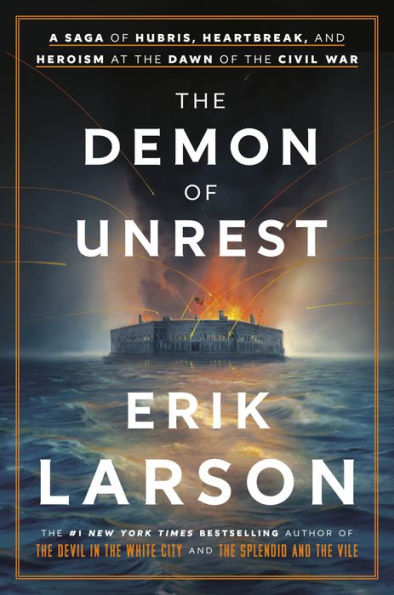Read an Excerpt
A Boat in the Dark
The oars were audible before the boat came into view, this despite a noisy wind that coarsened the waters of the bay. It was very late on a black night. The rain, according to one account, “fell in torrents, and the wind howled weird-like and drearily.” In recent weeks the weather had been erratic: seductively vernal one day, bone-wrackingly cold the next. One morning there was snow. For a week a strong gale had scoured the coast. The four enslaved men rowing the boat made steady progress despite the wind and chop, and hauled their cargo—three white Confederate officers—with seeming ease. They covered the distance from Charleston to the fortress in about forty-five minutes. Until recently, a big lantern incorporating the latest in Fresnel lenses had capped the fort’s lighthouse, but in preparing for war, Army engineers had moved it. Now the lantern stood elevated on trestles at the center of the enclosed grounds, the “parade,” where it lit the interior faces of the surrounding fifty-foot walls and the rumps of giant cannon facing out through ground-level casemates. From afar, at night, in the mist, the light transformed the fortress into an immense cauldron steaming with pale smoke. The boat reached its wharf at twelve forty-five a.m., Friday, April 12, 1861, destined to be the single-most consequential day in American history.
Over the last 113 days, the fort’s commander, Maj. Robert Anderson, and his garrison of U.S. Army regulars, along with a cadre of men under Capt. John G. Foster of the Army Corps of Engineers, had transformed it from a cluttered relic into an edifice of death and destruction. It was still drastically undermanned. Designed to be staffed by 650 soldiers, it now had only seventy-five, including officers, enlisted men, engineers, and members of the regimental band. But its guns were ready, nested within and atop its walls. Also, five large cannon had been mounted on makeshift platforms in the parade and pointed skyward to serve as mortars, these capable of throwing explosive shells into Charleston itself.
In those 113 days, this fortress, named for Thomas Sumter, a Revolutionary War hero, had become a profoundly dangerous place to invade and could have resisted attack quite possibly forever, but for one fatal flaw: It was staffed by men, and men had to eat. The food supply, cut off by Confederate authorities, had dwindled to nearly nothing.
Anderson was fifty-five years old, with a wife, Eliza (known universally as Eba), three daughters, and a one-year-old son, also named Robert. Anderson was clean-shaven, rare for the time, and this helped impart to his face a pleasant openness very unlike the hollow, axe-handle aspect of his Confederate opponent across the bay, his friend and former pupil Gen. P.G.T. Beauregard, who had taken command of all South Carolina military activities. Their relationship was courteous and cordial, almost warm, despite Beauregard’s obvious willingness to kill Anderson and all his men if it meant furthering the cause of Southern independence.
Anderson adored his family and mourned the separation from them that was so often required by the Army. Thanks to income from Eba’s family, they lived a life they could not have afforded on his salary alone. They owned a house on West Ninth Street in New York, but with Anderson’s rising notoriety, Eba and the children moved into the nearby Brevoort House hotel, a luxurious five-story structure on Fifth Avenue. Their daughters went to boarding school in New Jersey, a measure meant, apparently, to ease the burden of child-rearing for Eba, who suffered from an indeterminate chronic illness, which Anderson in one letter described as her “long continued indisposition.”
Eba’s condition made Anderson all the more attentive to her. “What would I not give to know that you passed a comfortable night, and that you feel much better this morning,” he wrote on one occasion. He was prone to loving endearments. “I do not know what I should do without you, my precious pet,” or simply “my precious,” or “my own dear little wife.” To save her the physical strain of writing letters, he proposed a pact: He would continue to write to her every day in multipage, diary-like accounts, but she would be obligated to write to him only once a week.
Anderson was a deeply religious man. To Eba: “I pray that Our Heavenly Father may, ere long, rejoice my old heart by restoring you to health, such that we may be together as long as we live.” He summoned the beneficence of God even in formal reports to the War Department. One of his officers wrote, “I never met a man who trusts more quietly and at the same time more contentedly upon the efficacy of prayer.” Lately a consistent element of his prayers was a plea that war would not come.
On the stillest nights, at nine o’clock, Major Anderson could hear the great bells in the distant witch-cap spire of St. Michael’s Church, bastion of Charleston society where planters displayed rank by purchasing pews. It stood adjacent to Ryan’s Slave Mart, and each night rang the “negro curfew” to alert the city’s enslaved and free Blacks that they had thirty minutes to return to their quarters, lest the nightly “slave patrol” find them and lock them in the guard house until morning.
Charleston was a central hub in the domestic slave trade, which in the wake of a fifty-year-old federal ban on international trading now thrived and accounted for much of the city’s wealth. The “Slave Schedule” of the 1860 U.S. Census listed 440 South Carolina planters who each held one hundred or more enslaved Blacks within a single district, this when the average number owned per slave-holding household nationwide was 10.2. In 1860, the South as a whole had 3.95 million slaves. One South Carolina family, the descendants of Nathaniel Heyward, owned over three thousand, of whom 2,590 resided within the state.
Together these planters constituted a kind of aristocracy and saw themselves as such. They called themselves “the chivalry.” As the prominent South Carolina planter James Henry Hammond put it, they were “the nearest to noblemen of any possible in America.” This idea was affirmed on a daily basis by the fact of their possession of, and dominion over, a subservient population of enslaved Blacks. But with this also came a deep fear that this population over which they exercised such stern rule might one day rise in rebellion. The 1860 federal census found that the state had 111,000 more enslaved people than it did whites; it was, moreover, one of only two states where this kind of imbalance existed, the other being Mississippi. Free and enslaved Blacks together accounted for over 40 percent of the population of South Carolina’s chief city, Charleston, and this caused uneasiness among its white citizens. Planters built what were in effect backyard plantations with two or more out-structures housing kitchens, stables, and slave quarters and surrounded by high walls to limit the dangers of insurrection and midnight murder. Any enslaved person who worked outside these walls had to wear a special badge, a metal medallion—square, round, octagonal—stamped “Charleston,” with the year, type of job, and an identification number pinned to clothing or hung around the neck. The effect of this overwhelming slave presence was immediately evident to travelers from the North. “How strange the aspect of this city!” one such visitor observed. “Every street corner, and door-sill filled with blacks; blacks driving the drays & carriages, blacks carrying burdens, blacks tending children & vending articles on the sidewalks; blacks doing all.”
Not only did the state’s planters call themselves “the chivalry”; they devoured chivalric novels, like Sir Walter Scott’s Ivanhoe and Tennyson’s Idylls of the King. They held jousting competitions, called “heads and rings,” where a rider bearing the name of one of Scott’s or Tennyson’s knights, wearing knightly garb and holding a long lance, would ride at full gallop and attempt to spear a series of dangling metal rings as small as half an inch in diameter, then draw his saber to take an exuberant swipe at the head of an inanimate figure at the end of the course. The chivalry gave themselves military titles and favored elaborate uniforms. Their South Carolina standard-bearer, novelist William Gilmore Simms, wrote eighty-two novels in which chivalry and honor were central themes. Chivalry, to him, meant “gallantry, stimulated by courage, warmed by enthusiasm, and refined by courtesy.” The chivalry valued honor above all human traits and would happily kill to sustain it, but only in accord with the rules set out in the Code Duello, which specified exactly how a man suffering an abrasion of honor could challenge and, if he wished, murder another.











